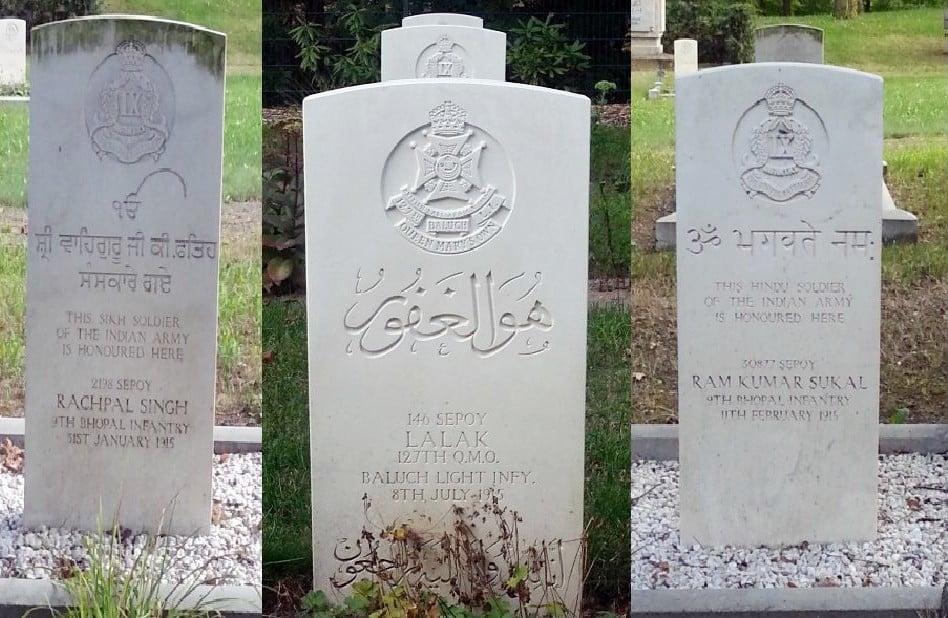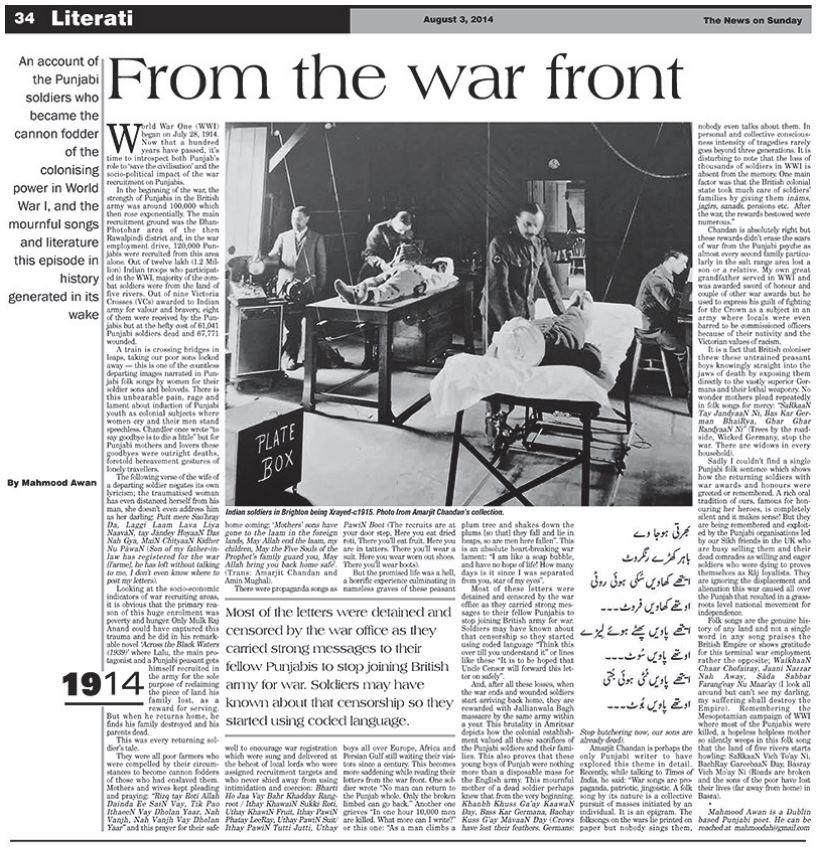Mahmood Awan (The News on Sunday, 3rd August 2014)
World War One (WWI) began on July 28, 1914. Now that a hundred years have passed, it’s time to introspect both Punjab’s role to ‘save the civilisation’ and the socio-political impact of the war recruitment on Punjabis.
At the beginning of the war, strength of the Punjabis in the British army was around 100,000 and then it rose exponentially. Foreign and Commonwealth Office (FCO) UK gives a count of 1.2 million Indian soldiers while as per David Omissi and Rajit Mazumder, during the war years, till December 1919, India recruited 1,440,437 men, including 877,068 combatants and 563,369 non-combatants. By the end of the war, Punjab had provided some 360,000 combat recruits (almost half of all Indian combat force), including 136000 Muslims, 88,925 Sikhs and 23,000 Dogras (Hindus). The main recruitment ground was the Dhan-Photohar area of the then Rawalpindi district and in the war employment drive 120,000 Punjabis were recruited from this area alone and majority of them were Muslims. Out of nine Victoria Crosses (VCs) awarded to Indian army for valour and bravery, many of them are Punjabis but at the hefty cost of 61,041 Punjabi soldiers dead and 67,771 wounded.
An army train is crossing bridges in leaps, taking our poor sons locked away — this is one of the countless departing images narrated in Punjabi folk songs by women for their soldier sons and beloveds. There is this unbearable pain, rage and lament about induction of Punjabi youth as colonial subjects where women cry and their men stand speechless. Chandler once wrote “to say goodbye is to die a little” but for Punjabi mothers and lovers these goodbyes were outright deaths, foretold bereavement gestures of lonely travellers.
The following verse of the wife of a departing soldier negates its own lyricism; the traumatised woman has even distanced herself from his man, she doesn’t even address him as her darling: Putt mere Sao’hray Da, Laggi Laam Lava Liya NaavãN, tay Jãndey HoyaaN Das Nah Gya, MaiN ChityaaN Kidher Nu PãwaN (Son of my father-in-law has registered for the war [l’arme], he has left without talking to me, I don’t even know where to post my letters).
Looking at the socio-economic indicators of war recruiting areas, it is obvious that the primary reason of this huge enrolment was poverty and hunger. Only Mulk Raj Anand could have captured this trauma and he did in his remarkable novel ‘Across the Black Waters (1939)’ where Lalu, the main protagonist and a Punjabi peasant gets himself recruited in the army for the sole purpose of reclaiming the piece of land his family lost, as a reward for serving. But when he returns home, he finds his family destroyed and his parents dead.
This was every returning soldier’s tale.
They were all poor farmers who were compelled by their circumstances to become cannon fodders of those who had enslaved them. Mothers and wives kept pleading and praying: “Rizq tay Roti Allah Dainda Ee SaiN Vay, Tik Pao IthaeeN Vay Dholan Yaar, Nah Vanjh, Nah Vanjh Vay Dholan Yaar” and this prayer for their safe home coming: ‘Mothers’ sons have gone to the laam in the foreign lands, May Allah end the laam, my children, May the Five Souls of the Prophet’s family guard you, May Allah bring you back home safe’. (Trans: Amarjit Chandan and Amin Mughal).
There were propaganda songs as well to encourage war registration which were sung and delivered at the behest of local lords who were assigned recruitment targets and who never shied away from using intimidation and coercion: Bharti Ho Jaa Vay Bahr Khadday Rangroot / Ithay KhawaiN Sukki Roti, Uthay KhawiN Fruit, Ithay PawiN Phatay LeeRay, Uthay PawiN Suit/ Ithay PawiN Tutti Jutti, Uthay PawiN Boot (The recruits are at your door step, Here you eat dried roti, There you’ll eat fruit. Here you are in tatters. There you’ll wear a suit. Here you wear worn out shoes. There you’ll wear boots).
But the promised life was a hell, a horrific experience culminating in nameless graves of these peasant boys all over Europe, Africa and Persian Gulf still waiting their visitors since a century. This becomes more saddening while reading their letters from the war front. One soldier wrote “No man can return to the Punjab whole. Only the broken limbed can go back.” Another one grieves “In one hour 10,000 men are killed. What more can I write?” or this one: “As a man climbs a plum tree and shakes down the plums [so that] they fall and lie in heaps, so are men here fallen”. This is an absolute heart-breaking war lament: “I am like a soap bubble, and have no hope of life! How many days is it since I was separated from you, star of my eyes”.
Most of these letters were detained and censored by the war office as they carried strong messages to their fellow Punjabis to stop joining British army for war. Soldiers may have known about that censorship so they started using coded language “Think this over till you understand it” or lines like these “It is to be hoped that Uncle Censor will forward this letter on safely”.
And, after all these losses, when the war ends and wounded soldiers start arriving back home, they are rewarded with Jallianwala Bagh massacre by the same army within a year. This brutality in Amritsar depicts how the colonial establishment valued all these sacrifices of the Punjabi soldiers and their families. This also proves that these young boys of Punjab were nothing more than a disposable mass for the English army. This mournful mother of a dead soldier perhaps knew that from the very beginning: Khanbh Khuss Ga’ay KaawaN Day, Bass Kar Germana, Bachay Kuss G’ay MãvaaN Day (Crows have lost their feathers. Germans: Stop butchering now, our sons are already dead).
Amarjit Chandan is perhaps the only Punjabi writer to have explored this theme in detail. Recently, while talking to Times of India, he said: “War songs are propaganda, patriotic, jingoistic. A folk song by its nature is a collective pursuit of masses initiated by an individual. It is an epigram. The folksongs on the wars lie printed on paper but nobody sings them, nobody even talks about them. In personal and collective consciousness intensity of tragedies rarely goes beyond three generations. It is disturbing to note that the loss of thousands of soldiers in WWI is absent from the memory. One main factor was that the British colonial state took much care of soldiers’ families by giving them inãms, jagirs, sanads, pensions etc. After the war, the rewards bestowed were numerous.”
Chandan is absolutely right but these rewards didn’t erase the scars of war from the Punjabi psyche as almost every second family particularly in the salt range area lost a son or a relative. My own great grandfather served in WWI and was awarded sword of honour and couple of other war awards but he used to express his guilt of fighting for the Crown as a subject in an army where locals were even barred to be commissioned officers because of their nativity and the Victorian values of racism.
It is a fact that British coloniser threw these untrained peasant boys knowingly straight into the jaws of death by exposing them directly to the vastly superior Germans and their lethal weaponry. No wonder mothers plead repeatedly in folk songs for mercy: “SaRkaaN Tay JandyaaN Ni, Bas Kar German BhaiRya, Ghar Ghar RandyaaN Ni” (Trees by the roadside, Wicked Germany, stop the war. There are widows in every household).
Sadly I couldn’t find a single Punjabi folk line which shows how the returning soldiers with war awards and honours were greeted or remembered. A rich oral tradition of ours famous for honouring her heroes is completely silent. But they are being remembered and cashed in by Punjabi organisations lead by our Sikh friends in the UK who are busy selling them and their dead comrades as willing and eager soldiers who were dying to proves themselves as Rãj loyalists. They are ignoring the displacement and alienation this war caused all over the Punjab that resulted into a grass root level national movement for independence. They are also white-washing the coercion and conscription involved in the WW1 recruitment by the likes of Umar Hayat Tiwana in Shahpur district and other ‘land awardees’ at the behest of the English which is widely known.
Folk songs are the genuine history of any land and not a single word in any song praises the British Empire or shows gratitude for this terminal war employment rather the opposite; WaikhaaN Chaar Chofairay, Jaani Nazzar Nah Away, Sãda Sabbar Farang’eay Nu Maar’ay (I look all around but can’t see my darling, my patience full of suffering shall destroy the Empire). Remembering the Mesopotamian campaign of WWI where most of the Punjabis were killed, a hopeless helpless mother so silently weeps in this folk song that the land of five rivers starts howling: SaRkaaN Vich To’ay Ni, BachRay GareebaaN Day, Basray Vich Mo’ay Ni (Roads are broken and the sons of the poor have lost their lives (far away from home) in Basra).
Published on 3rd August 2014 in The News on Sunday.
https://www.thenews.com.pk/tns/detail/556783-punjabi-soldiers-on-the-war-front


